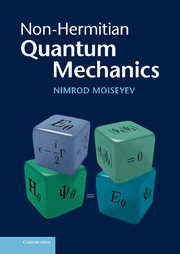Refine search
Actions for selected content:
3361 results in Quantum Physics, Quantum Information and Quantum Computation

Non-Hermitian Quantum Mechanics
-
- Published online:
- 03 May 2011
- Print publication:
- 17 February 2011
11 - Foliable Operational Structures for General Probabilistic Theories
- from III - Behind the Hilbert Space Formalism
-
-
- Book:
- Deep Beauty
- Published online:
- 01 June 2011
- Print publication:
- 18 April 2011, pp 409-442
-
- Chapter
- Export citation
Introduction
-
-
- Book:
- Deep Beauty
- Published online:
- 01 June 2011
- Print publication:
- 18 April 2011, pp 1-10
-
- Chapter
- Export citation
Acknowledgments
-
- Book:
- Deep Beauty
- Published online:
- 01 June 2011
- Print publication:
- 18 April 2011, pp xiii-xiv
-
- Chapter
- Export citation
6 - Bohrification
- from I - Beyond the Hilbert Space Formalism: Category Theory
-
-
- Book:
- Deep Beauty
- Published online:
- 01 June 2011
- Print publication:
- 18 April 2011, pp 271-314
-
- Chapter
- Export citation
Index
-
- Book:
- Deep Beauty
- Published online:
- 01 June 2011
- Print publication:
- 18 April 2011, pp 455-472
-
- Chapter
- Export citation
1 - A Prehistory of n-Categorical Physics
- from I - Beyond the Hilbert Space Formalism: Category Theory
-
-
- Book:
- Deep Beauty
- Published online:
- 01 June 2011
- Print publication:
- 18 April 2011, pp 13-128
-
- Chapter
- Export citation
7 - Yet More Ado about Nothing: The Remarkable Relativistic Vacuum State
- from II - Beyond the Hilbert Space Formalism: Operator Algebras
-
-
- Book:
- Deep Beauty
- Published online:
- 01 June 2011
- Print publication:
- 18 April 2011, pp 317-342
-
- Chapter
- Export citation
III - Behind the Hilbert Space Formalism
-
- Book:
- Deep Beauty
- Published online:
- 01 June 2011
- Print publication:
- 18 April 2011, pp 363-364
-
- Chapter
- Export citation
2 - A Universe of Processes and Some of Its Guises
- from I - Beyond the Hilbert Space Formalism: Category Theory
-
-
- Book:
- Deep Beauty
- Published online:
- 01 June 2011
- Print publication:
- 18 April 2011, pp 129-186
-
- Chapter
- Export citation
3 - Topos Methods in the Foundations of Physics
- from I - Beyond the Hilbert Space Formalism: Category Theory
-
-
- Book:
- Deep Beauty
- Published online:
- 01 June 2011
- Print publication:
- 18 April 2011, pp 187-206
-
- Chapter
- Export citation
II - Beyond the Hilbert Space Formalism: Operator Algebras
-
- Book:
- Deep Beauty
- Published online:
- 01 June 2011
- Print publication:
- 18 April 2011, pp 315-316
-
- Chapter
- Export citation
12 - The Strong Free Will Theorem
- from III - Behind the Hilbert Space Formalism
-
-
- Book:
- Deep Beauty
- Published online:
- 01 June 2011
- Print publication:
- 18 April 2011, pp 443-454
-
- Chapter
- Export citation
Preface
-
-
- Book:
- Deep Beauty
- Published online:
- 01 June 2011
- Print publication:
- 18 April 2011, pp xi-xii
-
- Chapter
- Export citation
9 - Quantum Theory and Beyond: Is Entanglement Special?
- from III - Behind the Hilbert Space Formalism
-
-
- Book:
- Deep Beauty
- Published online:
- 01 June 2011
- Print publication:
- 18 April 2011, pp 365-392
-
- Chapter
- Export citation
5 - Classical and Quantum Observables
- from I - Beyond the Hilbert Space Formalism: Category Theory
-
-
- Book:
- Deep Beauty
- Published online:
- 01 June 2011
- Print publication:
- 18 April 2011, pp 239-270
-
- Chapter
- Export citation
10 - Is Von Neumann's “No Hidden Variables” Proof Silly?
- from III - Behind the Hilbert Space Formalism
-
-
- Book:
- Deep Beauty
- Published online:
- 01 June 2011
- Print publication:
- 18 April 2011, pp 393-408
-
- Chapter
- Export citation
Contributors
-
- Book:
- Deep Beauty
- Published online:
- 01 June 2011
- Print publication:
- 18 April 2011, pp ix-x
-
- Chapter
- Export citation
I - Beyond the Hilbert Space Formalism: Category Theory
-
- Book:
- Deep Beauty
- Published online:
- 01 June 2011
- Print publication:
- 18 April 2011, pp 11-12
-
- Chapter
- Export citation
4 - The Physical Interpretation of Daseinisation
- from I - Beyond the Hilbert Space Formalism: Category Theory
-
-
- Book:
- Deep Beauty
- Published online:
- 01 June 2011
- Print publication:
- 18 April 2011, pp 207-238
-
- Chapter
- Export citation
